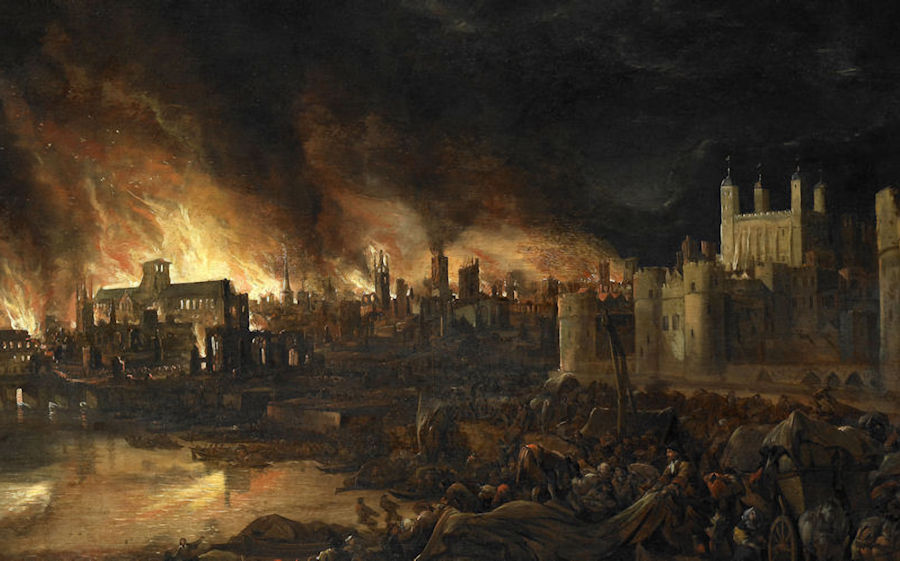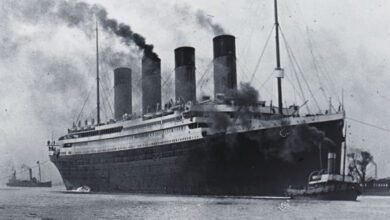
Podcast: Play in new window | Download
On the evening of September 2, 1666, a fire started in the bakery of Thomas Farriner which was located on Pudding Lane near London Bridge. It was the start of a major disaster which, over the next few days, would go on to consume 430 acres, encompassing over 13,000 homes and over 80 churches, including St. Paul’s Cathedral, a total of 80% of the city’s footprint at that time.
In the wee hours of the morning, one of the bakery workers awoke to find the building consumed by flames. It is alleged that the fire started due to the maid failing to ensure the ovens were not still lit at the end of the day and the ovens sent out embers that set the bakery alight. Farriner and his family were able to get out alive, but the maid died in her attempt to escape.
The houses of London were predominantly made of wood and sealed against the elements by pitch, both of which are flammable materials. Couple this with the fact it was the end of September after a long period of drought and the air was dry and accompanied by late Summer breezes. The single building fire didn’t take long to jump across the narrow streets to adjoining buildings. The nearby Star Inn ignited due to the hay used to feed the animals and the winds blew embers to the Church of Saint Margaret and that caught fire too.
The lead roof on St. Paul’s Cathedral melted due to the heat and flowed down the building into the streets below. Thames Street was next. The wharves and warehouses along the way fed the fire further, thanks to the hay, coal, alcohol, tallow, and hemp stored in them. Try as they might, the citizens were no match. They hauled water from the river and attempted to put out the fire bucket by bucket, but it was no help.
Once he received the news, the Lord Mayor, Sir Thomas Bloodworth, was not overly worried about the fire. His remark, “A woman could piss it out” was not only vulgar but dismissive.
By 8 am, the fire had been raging for six hours and was about to take down London Bridge, having reached the halfway point of the structure. The fire was arrested at the other side by a lack of buildings which had themselves been destroyed 33 years earlier by a fire.
London’s residents fled and assembled on nearby hills, where all they could do was watch the conflagration. They received military rations as food courtesy of an order from the King. It is alleged that birds died due to their feathers being singed by the fire, causing them to plummet to the ground.
The firebreaks that were attempted were disastrous and ineffective. Houses were blown up with gunpowder and good structures were sacrificed in the attempt to create firebreaks by the Trained Bands of London, but that didn’t stop the fire from advancing. It finally slowed down when it reached Temple Church, but not for long and soon it had advanced on Westminster. The Duke of York ordered the Paper House to be torn down to create a new firebreak, and this, plus the fact the winds switched directions, finally arrested the fire. It was Wednesday, September 5 and the fire had been raging for over three days.
Mercifully, in the aftermath, it was determined that as few as 16 people died. However, thousands were left homeless and hundreds of businesses had been destroyed leaving the people with no way to make money with which they could recover and rebuild.
Much of the narrative of the fire was written down by Samuel Pepys, who recorded the events in his diary. One of his entries read, “I saw a fire as one entire arch of fire above a mile long: it made me weep to see it. The churches, houses are all on fire and flaming at once, and a horrid noise the flames made and the cracking of the houses.” It was he who informed the King of the extent of the damage after observing it from the Tower of London.
The fire added insult to injury, too. The Black Plague had ravaged the city only the year before, costing tens of thousands their lives although there was an upside to the fire as it helped remove the pestilence by killing many of the rats that spread the plague. The Fleet, then a major river in London, had been made so hot it nearly boiled, thus removing contaminants from it.
In the days following the fire, King Charles appointed six people to craft a new blueprint for the city, a committee headed by Sir Christopher Wren. Their findings led to the building of the City of London the layout for which remains to this day. Streets were made wider. Buildings were constructed of fire-impervious brick instead of wood. In just five years, over 9,000 buildings were completed, including homes and commercial establishments. The churches were rebuilt, too, including St. Paul’s Cathedral.
Today, a monument stands at the crossroads of Monument Street and Fish Street Hill, and exists both to commemorate the great fire of 1666 but also to celebrate the rebuilding of the city. It is only a stone’s throw from Pudding Lane itself, where the bakery once stood.
Podcast: Play in new window | Download





